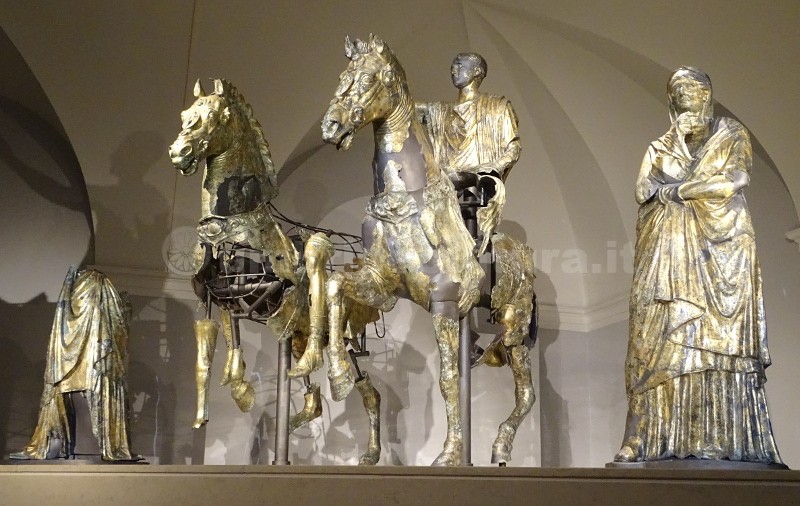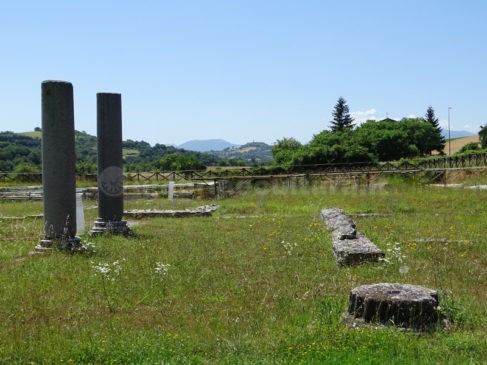Between east and west and sacred and profane symbols, the abbey of Santa Croce dei Conti Atti in Sassoferrato fascinates with its history and appearance.
Probably a Templar garrison, the exact dating of the foundation of the church of Santa Croce is not known: a first thesis refers it to the Counts Atti, dating back to 1100, while a document found in San Vittore, of a lawsuit filed among the various commanders of the church, the construction of the church dates back to 1090 and some scholars, given the capitals that adorn the columns, would even go back to the dating of the 9th century.
The square-plan Greek cross church, typical structure of Romanesque churches, is built over a temple dedicated to the god Mithras, with recycled materials from the Roman city of Sentinum, while the columns, made with gray granite from Egypt, probably come from Castelleone di Suasa.
Inside, a terracotta statue of San Rocco, missing from the dog stolen many years ago. The French saint, protector against the plague, wears the shell, symbol of the pilgrims, because he was the one who started the journey towards Santiago de Compostela.
A cinerary urn comes from Sentinum (the necropolis was never found in the Roman city, probably because the Romans made them the custom of the Gauls to cremate the dead), a funeral plaque of two freedmen who became prominent characters of the city.
Among the curiosities inside the church the incorrect wording carved over the Savior’s tabernacle where it reads “Corpus Domini” with an “r” added to correction and the famous “risque” capital which, according to Pagnani, would represent the sacrifice of Isaac, although the depiction of Abraham naked is inexplicable, while another hypothesis is that he would like to be Carlo Martello who, suffering from priapism, could not wear the vestments to go to war, often going naked, his presence for the soldiers it was a symbol of strength and virility; next to him his son Pepin the short, whose image closely resembles the one on the facade of the Collegiate Church of San Ginesio, and a further confirm is the very large sword typical of the Franks.
A fourteenth-century fresco on a pillar depicts Blessed Alberto, a monk who has always lived in this abbey and buried inside the church, who was invoked against headaches and intestinal pain.
The north-facing apse houses a fresco of 1300 divided into registers made up of paintings, from top to bottom the first four panels are dedicated to scenes from the life of St. Thomas the Apostle: St. Thomas who refuses food and is beaten by a servant; the servant is devoured by a lion and a wolf snatches the hand that hit the saint; St. Thomas preaching to the queen and the Indian princesses, finally martyrdom: St. Thomas blessing is shot to death and the pagan idols are broken.
On the lower register a “Madonna del latte” (Madonna feeding Jesus at her breast), Blessed Alberto, a Madonna and Child and a Crucifixion with the image of the client and Saint Catherine of Alexandria. In the missing part, on left of the Crucifix, one of the Counts Acts may have been portrayed, the last descendant hunted and killed because he was a tyrant, whose image would have been destroyed to erase his memory.
The altarpiece by Pietro Paolo Agabiti is from 1524 and depicts San Benedetto with San Placido, San Girolamo, Santa Scolastica and San Mauro with the client (the monk looking towards us), the author (the bearded monk) at his feet with folded hands, Blessed Alberto, buried there and Blessed Gherardo, who later became patron of Serra dei Conti.
The 1600 antependium, by Leonardo Scaglia, was bought for 40 scudi at a Franciscan church in Camerino.
A fresco depicting San Romualdo is a trace of the presence of the Camaldolese after the Benedictines.
Under another small fresco with St. Catherine of Alexandria with the wheel of martyrdom, a Roman altar, with the eagle gripping the hare and the laurel-bound stone symbol of the winner and the loser, always from Sentinum.
Above the chapel of the Blessed Sacrament and the Madonna of the Seven Sorrows, the double-tailed siren, which was once placed outside the brothel, symbolized opulence, prosperity, abundance, for the ancients it also represented the mother earth who created the world. Unfortunately, the bell was made with Sentinum bronze statues.
The church of Santa Croce in Sassoferrato has a further peculiarity: the pillars towards the altar are 20 cm lower than those towards the entrance. Some argue that it was intentionally built to collect energy, in this regard measurements of electromagnetic waves were made and actually, in some places of the church, the energy is 2,400,000 higher than average. This should not be surprising: 9 and 14 meters under the church floor flows water, which is an excellent energy conductor.
Another mystery, which will remain unanswered, is what Germanic emperors, Napoleon and even Mussolini, who came to Santa Croce in Sassoferrato on August 19, 1926, came to look for in this place.
Benedetta Tintillini
Find Santa Croce dei Conti on Google Maps:




